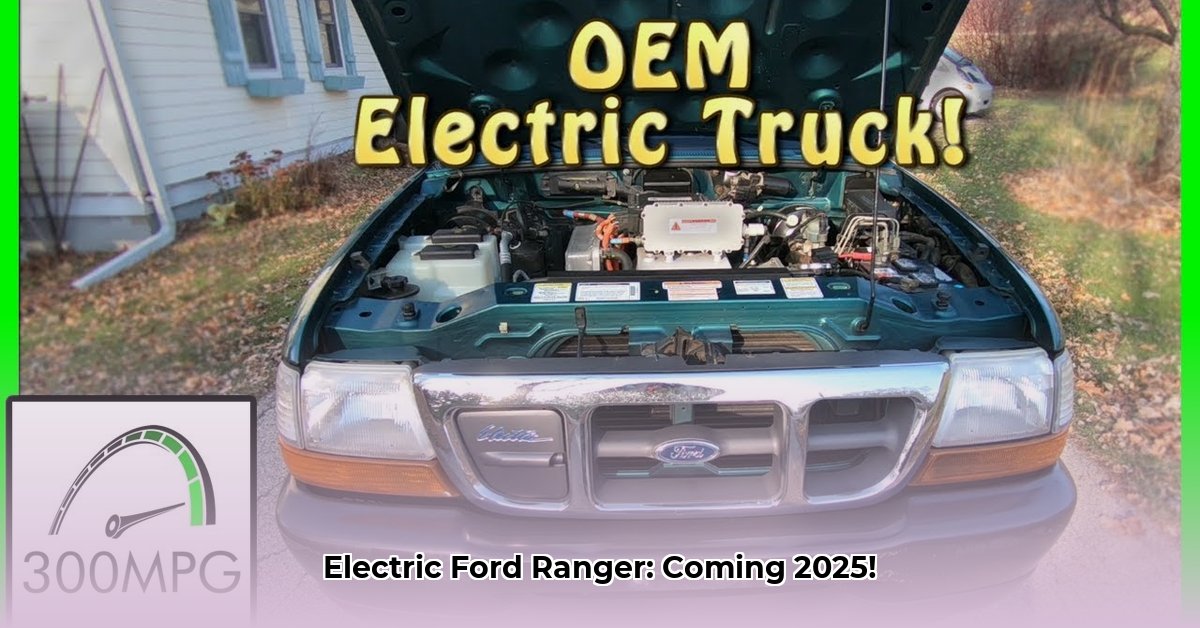
Ford's foray into the electric pickup truck market continues with the highly anticipated 2025 Ford Ranger Lightning. Following the success of the F-150 Lightning, the smaller Ranger aims to electrify a broader segment of the pickup truck market. This article delves into the specifics of the upcoming launch, offering a detailed look at projected specifications, market positioning, and the challenges and opportunities facing this innovative vehicle. For towing capacity details, see the 2024 Ranger specs.
What We Can Expect from Ford's Electric Ranger
While official specifications remain under wraps, we can extrapolate some key features based on the F-150 Lightning and industry trends. Expect a powerful all-wheel-drive system (likely with dual motors), a spacious "Mega Power Frunk" (front trunk), and the convenient Pro Power Onboard system, providing a built-in power source for tools and appliances. Crucially, a driving range of at least 300 miles (approximately 483 kilometers) is likely necessary to overcome "range anxiety" (the fear of running out of charge) and ensure market competitiveness. The vehicle's production at Ford's BlueOval City, a dedicated EV manufacturing facility, suggests a focus on cost-effective and environmentally conscious production methods.
Will the Ranger Lightning live up to the hype? Only time will tell. Its success depends largely on consumer adoption of electric trucks.
Facing the Competition: A Highly Competitive Market
The electric Ranger will face stiff competition from established automakers like Toyota, GM, and Nissan, all vying for a share of the burgeoning electric pickup truck market. To stand out, Ford must offer compelling features, competitive pricing, and possibly surpass competitors in driving range. The race for market share promises to be intense.
The Crucial Role of Charging Infrastructure
Driving range is only one piece of the puzzle. The availability of a comprehensive public charging network, particularly fast-charging stations, is equally vital. Without convenient and readily accessible charging options, range anxiety remains a significant deterrent for potential EV buyers. The electric Ranger's success is inextricably linked to the growth and reliability of public charging infrastructure.
Addressing Range Anxiety and Charging Concerns
Range anxiety—the fear of running out of charge—is a legitimate concern for prospective EV owners. Ford needs to deliver a compelling range, exceeding 300 miles ideally, coupled with fast-charging capabilities to minimize charging time. This necessitates close collaboration with charging networks to ensure readily available charging infrastructure.
Ford's Strategic Gamble: A Bold Move into the EV Market
Ford's substantial investment in electric vehicle technology, of which the electric Ranger is a central component, represents a significant strategic gamble. However, this appears to be a calculated risk, betting on the continued growth of the compact pickup truck market and the broader adoption of EVs. This forward-thinking strategy reflects Ford’s commitment to the future of electric vehicles.
Projected Pros and Cons of the Electric Ford Ranger
| Pros | Cons |
|---|---|
| Lower running costs compared to gasoline models | Range anxiety (potential concern) |
| Potential government tax credits or incentives | Dependence on the availability of charging stations |
| Environmentally friendly operation | Higher initial purchase price than gas models |
| Cutting-edge tech features | Potentially longer charging times than gasoline vehicles |
| Less maintenance | Long-term battery reliability (unproven) |
Timeline: Anticipated Key Milestones
| Milestone | Projected Timeline |
|---|---|
| Official specs announced | Early 2025 |
| Pre-orders opened | Mid-2025 |
| Production starts | Late 2025 |
| First customer deliveries | Early 2026 |
Important Note: These are projections based on current information. Always refer to official Ford announcements for the most accurate details.
How to Compare Ford Ranger Lightning Range to Competitors
The electric pickup truck market is fiercely competitive. How does the Ford Ranger Lightning's range measure up? A simple comparison of manufacturer-claimed ranges is insufficient. Real-world driving significantly impacts range.
Understanding Range Claims: The Need for Real-World Data
Manufacturer-provided ranges typically reflect ideal conditions. Real-world range varies based on driving style, terrain, weather, payload, and climate control usage. To compare effectively, rely on real-world data from independent reviews.
Comparing Features Beyond Range: A Multifaceted Approach
Range is just one factor. Consider:
- Payload and Towing Capacity: Crucial for pickup truck utility.
- Technology and Features: Advanced driver-assistance and infotainment.
- Charging Capabilities: Charging speed and network accessibility are key factors.
- Price: Total cost of ownership needs to be considered.
A Practical Approach to Comparison: A Step-by-Step Guide
- Identify Your Needs: What are your priorities in a pickup?
- Consult Independent Reviews: Seek out real-world range testing data from reliable sources.
- Compare Specifications: Examine manufacturer details carefully while noting the testing conditions.
- Factor in Real-World Conditions: Account for variations in driving scenarios.
- Consider Total Cost of Ownership: Factor in all costs, including long-term maintenance and potential resale value.
The Ranger Lightning's Market Positioning: A Balanced Approach
Ford positions the Ranger Lightning as a balance between affordability and capability. While pricing is projected to be competitive, success depends on production efficiency, supply chain management, and meeting consumer expectations. The rapid evolution of battery technology and charging infrastructure will also play a crucial role in its long-term market performance.